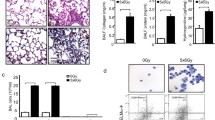Background and Purpose:
The precise pathophysiological mechanisms of radiation-induced lung injury are poorly understood, but have been shown to correlate with dysregulation of different cytokines. The purpose of this study was to evaluate the time course of the pro-inflammatory cytokines tumor necrosis factor-(TNF-)α, interleukin-(IL-)1α and IL-6 after whole-lung irradiation.
Material and Methods:
The thoraces of C57BL/6J mice were irradiated with 12 Gy. Treated and control mice were sacrificed at 0.5, 1, 3, 6, 12, 24, 48, 72 h, 1, 2, 4, 8, 16, and 24 weeks post irradiation (p. i.). Real-time multiplex RT-PCR (reverse transcriptase polmyerase chain reaction) was established to evaluate the expression of TNF-α, IL-1α and IL-6 in the lung tissue of the mice. For histological analysis, lung tissue sections were stained by hematoxylin and eosin.
Results:
Multiplex RT-PCR analysis revealed a biphasic expression of these pro-inflammatory cytokines in the lung tissue after irradiation. After an initial increase at 1 h p. i. for TNF-α and at 6 h p. i. for IL-1α and IL-6, the mRNA expression of these pro-inflammatory cytokines returned to basal levels (48 h, 72 h, 1 week, 2 weeks p. i.). During the pneumonic phase, TNF-α, IL-1α and IL-6 were significantly elevated and revealed their maximum at 8 weeks p. i. Histopathologic evaluation of the lung sections obtained within 4 weeks p. i. revealed only minor lung damage in 5–30% of the lung tissue. By contrast, at 8, 16, and 24 weeks p. i., 70–90% of the lung tissue revealed histopathologically detectable organizing alveolitis.
Conclusion:
Irradiation induces a biphasic expression of pro-inflammatory cytokines in the lung. The initial transitory cytokine response occurred within the first hours after lung irradiation with no detectable histopathologic alterations. The second, more persistent cytokine elevation coincided with the onset of histologically discernible organizing acute pneumonitis.
Hintergrund und Ziel:
Die genaue Pathophysiologie der strahleninduzierten Lungenschädigung ist bislang nur unvollständig geklärt, scheint aber mit einer Dysregulation verschiedener Zytokine assoziiert zu sein. Das Ziel dieser experimentellen Studie war es, den zeitlichen Expressionsverlauf der proinflammatorischen Zytokine Tumor-Nekrose-Faktor-(TNF-)α, Interleukin-(IL-)1α und IL-6 nach Lungenbestrahlung zu untersuchen.
Material und Methodik:
Bei C57BL/6J-Mäusen wurde eine Ganzlungenbestrahlung mit 12 Gy durchgeführt. Die Versuchstiere und unbestrahlte Kontrolltiere wurden zu unterschiedlichen Zeitpunkten (0,5, 1, 3, 6, 12, 24, 48, 72 h bzw. 1, 2, 4, 8, 16 und 24 Wochen) nach Bestrahlung getötet. Im Lungengewebe wurde die mRNA-Expression von TNF-α, IL-1α und IL-6 mit Hilfe der Real-Time-multiplex-RT-PCR (Reverse-Transkriptase-Polymerase-Kettenreaktion) quantifiziert. Für die histologische Beurteilung der Lungenpräparate wurde eine Hämatoxylin-Eosin-Färbung durchgeführt.
Ergebnisse:
Im Rahmen der strahleninduzierten Lungenschädigung konnte mit Hilfe der Multiplex-RT-PCR eine biphasische Expression dieser proinflammatorischen Zytokine nachgewiesen werden. Nach einem initialen Anstieg—bereits 1 h nach Bestrahlung für TNF-α und nach 6 h für IL-1α und IL-6—ging die Zytokinexpression auf Ausgangswerte zurück. Während der Pneumonitisphase war die mRNA-Expression von TNF-α, IL-1α und IL-6 signifikant erhöht und ereichte 8 Wochen nach Bestrahlung ihr Maximum. Während sich bis zu 4 Wochen nach Bestrahlung histopathologisch nur eine geringe Lungenschädigung in 5–30% des Gesamtlungengewebes beobachten ließ, waren nach 8, 16 bzw. 24 Wochen 70–90% des Gesamtlungengewebes im Sinne einer radiogenen Pneumonitis geschädigt.
Schlussfolgerung:
Im Rahmen der radiogenen Lungenreaktion konnte eine biphasische Expression der proinflammatorischen Zytokine nachgewiesen werden. Die initiale Zytokinerhöhung erfolgte in den ersten Stunden nach Lungenbestrahlung, ohne dass histopathologisch eine Lungenschädigung nachweisbar war. Die zweite, länger persistierende Zytokinerhöhung (einige Wochen nach Bestrahlung) korrelierte mit dem Beginn einer histologisch nachweisbaren radiogenen Pneumonitis.
Similar content being viewed by others
Author information
Authors and Affiliations
Corresponding author
Rights and permissions
About this article
Cite this article
Rübe, C.E., Wilfert, F., Palm, J. et al. Irradiation Induces a Biphasic Expression of Pro-Inflammatory Cytokines in the Lung. Strahlenther Onkol 180, 442–448 (2004). https://doi.org/10.1007/s00066-004-1265-7
Received:
Accepted:
Published:
Issue Date:
DOI: https://doi.org/10.1007/s00066-004-1265-7




